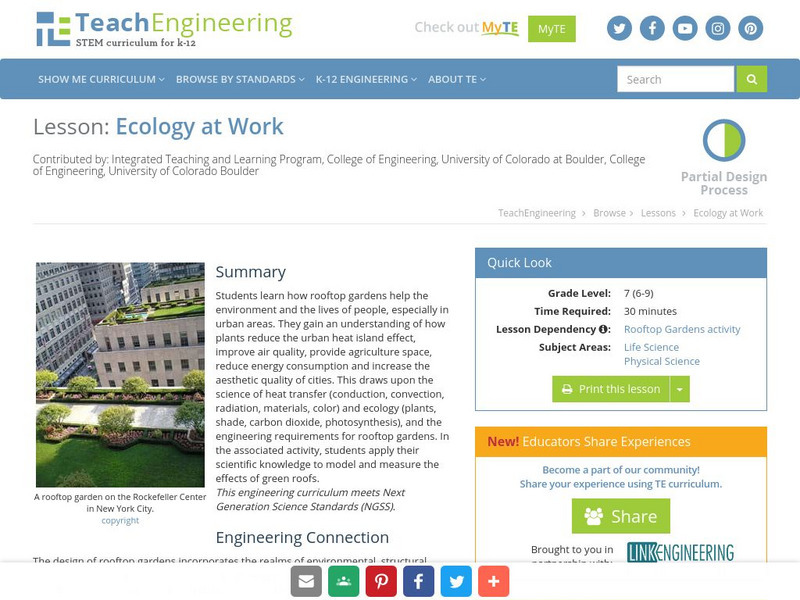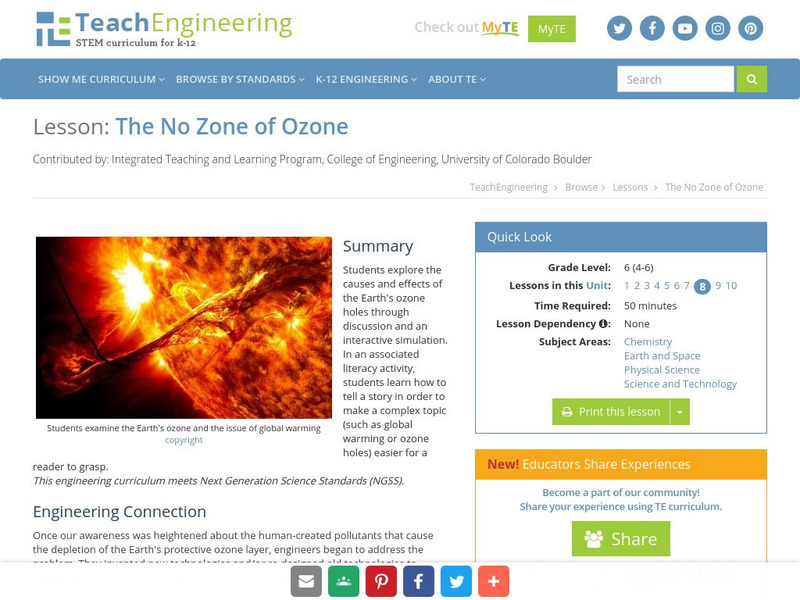Hi, what do you want to do?
NOAA
Noaa: Ocean Explorer: The Methane Circus
In this activity students will understand the events occuring during the Cambrian explosion. They will also begin to explain how methane hydrates contribute to global warming. Finally, they will discuss links between methane hydrates...
Climate Literacy
Clean: Do Scientists Agree About the Causes of Climate Change?
Students follow a four-step process to debunk the myth regarding scientific consensus on climate change.
TeachEngineering
Teach Engineering: Ecology at Work
Students learn how rooftop gardens help the environment and the lives of people, especially in urban areas. They gain an understanding of how plants reduce the urban heat island effect, improve air quality, provide agriculture space,...
National Association of Geoscience Teachers
Nagt: History of Climate Science
For this activity. students synthesize ideas and critically evaluate the current social perspectives of climate science and social decision-making.
TeachEngineering
Teach Engineering: Carbon Cycles
Students are introduced to the concept of energy cycles by learning about the carbon cycle. They will learn how carbon atoms travel through the geological (ancient) carbon cycle and the biological/physical carbon cycle. Students will...
National Earth Science Teachers Association
Windows to the Universe: Changing Planet: Melting Glaciers
Students sort photographs of glaciers and measure glacial retreat to observe how alpine glaciers have retreated over the past century. Includes a printable worksheet, links to relevant materials, and extension activities.
Climate Literacy
Clean: Public Service Announcement (Psa) for Grades 6 12
Students study climate change and create a Public Service Announcement that communicates their understanding of the science, raises awareness about climate change, and motivates people to take action.
TeachEngineering
Teach Engineering: The No Zone of Ozone
Young scholars explore the causes and effects of the Earth's ozone holes through discussion and an interactive simulation. In an associated literacy activity, students learn how to tell a story in order to make a complex topic (such as...
University of Wisconsin
Uw: Probabilities, Uncertainties and Units Used to Quantify Climate Change
This resource engages learners in using scientific data to analyze a 150-year dataset from Lake Mendota in Madison Wisconsin reflecting seasonal ice cover.
Climate Literacy
Clean: Person on the Street (Pos) Interview About Climate Science
A media project where students create a video that documents unrehearsed interviews with "people on the street" about a specific question or issue in climate science.
Science Education Resource Center at Carleton College
Serc: Greenhouse Effect Lab
Students measure temperature changes inside soda bottles filled with CO2 and air as incandescent light is shined on them to model the Greenhouse Effect.
Climate Literacy
Clean: Greenhouse Gas in a Bottle Demonstration
A simple demonstration that is quick and easy to setup and provides dramatic evidence of the effect on temperature of an atmosphere with increased carbon dioxide. [4 min]
PBS
Nova: Extreme Ice
Students study how scientists monitor changes in Earth's glaciers, ice caps, and ice sheets. They investigate about glacier locations, glacial movement, and impacts of climate change on glaciers depending on the depth of research.
University Corporation for Atmospheric Research
Ucar: Co2: How Much Do You Spew?
Students analyze the energy consumption of a hypothetical household to determine the amount of carbon dioxide they are adding to the atmosphere each year.















